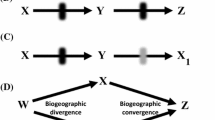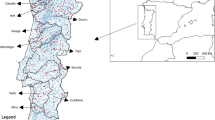Abstract
This study reformulates the community-unit and individualistic concepts of plant communities as hypotheses concerning the distribution of species' boundaries along a gradient. These hypotheses are tested by an analysis of deviance on data derived from a direct-gradient analysis of a freshwater marsh plant community in Breckenridge, Quebec, Canada. Boundaries are clustered at certain intervals along the gradient (p<0.001), contradicting the individualistic hypothesis. Upper boundaries are not consistently clustered at the same intervals as lower boundaries (p<0.001), contradicting the community-unit hypothesis. Thus, neither of the two usual models of community structure explain the patterns found in Breckenridge Marsh, suggesting that the historical dichotomy is too limited. Hypotheses of pattern should be tested using inferential statistics. Hypotheses of mechanism should be tested by experimentation. The way out of the community-unit vs. individualistic community debate is to deny the dichotomy and to consider multiple working hypotheses of community structure.
Similar content being viewed by others
References
Austin M. P., 1985. Continuum concept, ordination methods, and niche theory. Ann. Rev. Ecol. Syst. 16: 39–61.
Austin M. P., 1987. Models for the analysis of species' response to environmental gradients. Vegetatio 69: 35–45.
Austin M. P., Cunningham R. B. & Flemming P. M., 1984. New approaches to direct gradient analysis using environmental scalars and statistical curve-fitting procedures. Vegetatio 55: 11–27.
Cain S. A., 1947. Characteristics of natural areas and factors in their development. Ecol. Monogr. 17: 185–200.
Clements, E. E., 1916. Plant succession: an analysis of the development of vegetation. Publ. Carneg. Inst. 242.
Connell H. H., 1972. Community interactions in marine rocky intertidal shores. Ann. Rev. Ecol. Syst. 3: 169–192.
Connell H. H., 1983. On the prevalence and relative importance of interspecific competition: evidence from field experiments. Am. Nat. 122: 661–696.
Curtis J. T., 1955. A prairie continuum in Wisconsin. Ecology 36: 558–566.
Dale M. R. T., 1984. The contiguity of upslope and downslope boundaries in a zoned community. Oikos 43: 92–96.
Egler F. E., 1947. Arid southwest Oahu vegetation, Hawaii. Ecol. Monogr. 17: 383–435.
Gleason H. A., 1926. The individualistic concept of the plant association. Bull. Torrey Bot. Club. 53: 7–26.
Gleason H. A., 1939. The individualistic concept of the plant association. Am. Midl. Na. 21: 92–110.
Grace J. B. & Wetzel R. G., 1981. Habitat partitioning and competitive displacement in cattails (Typha): experimental field studies. Am. Nat. 118: 463–474.
Hutchinson G. E., 1975. A treatise on limnology, vol. 3. Limnological botany. Wiley, New York.
Karson M. J., 1982. Multivariate statistical methods. Iowa State Univ. Press, Iowa.
Keddy P. A., 1983. Shoreline vegetation in Axe Lake, Ontario: effects of exposure on zonation patterns. Ecology 64: 331–344.
Keddy P. A., 1985. Wave disturbance on lakeshores and the within-lake distribution of Ontario's Atlantic coastal plain flora. Can. J. Bot. 63: 656–660.
Levins R. & Lewontin R., 1982. Dialectics and reductionism in ecology. In: E.Saarinen (ed.), Conceptual issues in ecology, pp. 107–138. Reidel, Dordrecht.
Lubchenco J., 1980. Algal zonation in the New England rocky intertidal community: an experimental analysis. Ecology 61: 333–344.
Mason H. L., 1947. Evolution of certain floristic associations in western North America. Ecol. Monogr. 17: 201–210.
McCullogh P. & Nelder J. A., 1983. Generalized linear models. Chapman and Hall, London.
McIntosh R. P., 1967. The continuum concept of vegetation. Bot. Rev. 33: 130–187.
McIntosh R. P., 1975. H. A. Gleason-‘individualistic ecologist’ 1882–1975. His contributions to ecological theory. Bull. Torry Bot. Club 102: 253–273.
Paine R. T., 1984. Ecological determinism in the competition for space. Ecology 65: 1339–1348.
Pielou E. C. & Routledge R. D., 1976. Salt marsh vegetation: latitudinal variation in the zonation patterns. Oecologia 24: 311–321.
Pielou E. C., 1975. Ecological diversity. Wiley, New York.
Pielou E. C., 1977. Mathematical ecology. Wiley, New York.
Schoener T. W., 1983. Field experiments on interspecific competition. Am. Nat. 122: 240–285.
Sharitz R. R. & McCormick J. F., 1972. Population dynamics of two competing annual plant species. Ecology 54: 723–740.
Silander J. A. & Antonovics J., 1982. Analysis of interspecific interactions in a coastal plant community-a perturbation approach. Nature 298: 557–610.
Simberloff D., 1982a. A succession of paradigms in ecology: essentialism to materialism and probabilism. In: E.Saarinen (ed.), Conceptual issues in ecology, pp. 139–153. Reidel, Dordrecht.
Simberloff D., 1982b. Reply. In: E.Saarinen (ed.), Conceptual issues in ecology, pp. 139–153. Reidel, Dordrecht.
Snow A. A. & Vince S. W., 1984. Plant zonation in an Alaskan salt marsh I. Distribution, abundance and environmental factors. J. Ecol. 72: 651–667.
Sokal R. R. & Rohlf F. J., 1981. Biometry, 2nd ed. Freeman, San Francisco.
Spence D. H. N., 1982. The zonation of plants in freshwater lakes. Adv. Ecol. Res. 12: 37–125.
Turkington R. & Aarssen L. W., 1984. Local-scale differentiation as a result of competitive interactions. In: R.Dirzo & J.Sarukhan (eds), Perspectives on plant population biology, pp. 107–127. Sinauer, Sunderland, MA.
Underwood A. J., 1978. The detection of non-random patterns of distribution of species along an environmental gradient. Oecologia 36: 317–326.
Vince S. W. & Snow A. A., 1984. Plant zonation in an Alaskan salt marsh II. An experimental study of the role of edaphic conditions. J. Ecol. 72: 669–684.
Whittaker R. H., 1951. A criticism of the plant association and climatic climax concepts. Northwest Sci. 25: 17–31.
Whittaker R. H., 1956. Vegetation of the Great Smoky Mountains. Ecol. Monogr. 26: 1–80.
Whittaker R. H., 1962. Classification of natural communities. Bot. Rev. 28: 1–160.
Whittaker R. H., 1967. Gradient analysis of vegetation. Biol. Rev. 42: 207–264.
Whittaker R. H., 1975. Communities and ecosystems, 2nd ed. Macmillan, New York.
Author information
Authors and Affiliations
Additional information
Nomenclature as in Gleason & Cronquist (1963), Manual of vascular plants of notheastern United States and adjacent Canada, Boston, unless otherwise indicated except for the the grasses which are from Dore & McNeill (1980), Grasses of Ontario, Quebec.
The statistical advice of Dr L. Lefkovitch is gratefully acknowledged. We also thank Mme. Claire Gauthier for the use of her property, C. Kettle for assistance with data collection as well as Robin Day and Dr P. Catling for assistance with identification of species. This research was supported by a National Sciences and Engineering Research Council of Canada operating grant.
Rights and permissions
About this article
Cite this article
Shipley, B., Keddy, P.A. The individualistic and community-unit concepts as falsifiable hypotheses. Vegetatio 69, 47–55 (1987). https://doi.org/10.1007/BF00038686
Accepted:
Issue Date:
DOI: https://doi.org/10.1007/BF00038686




